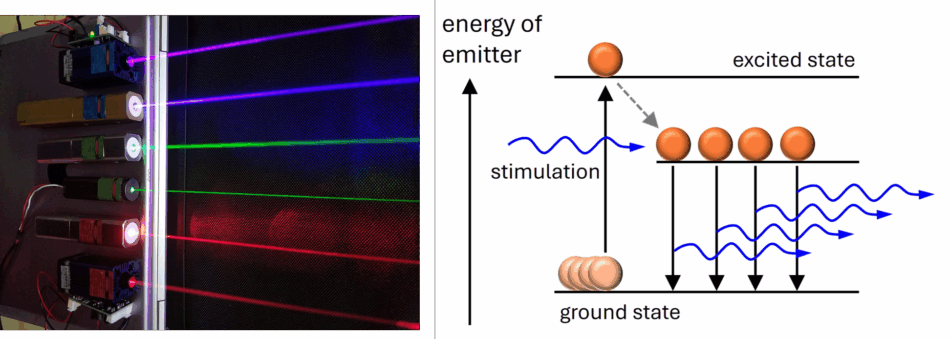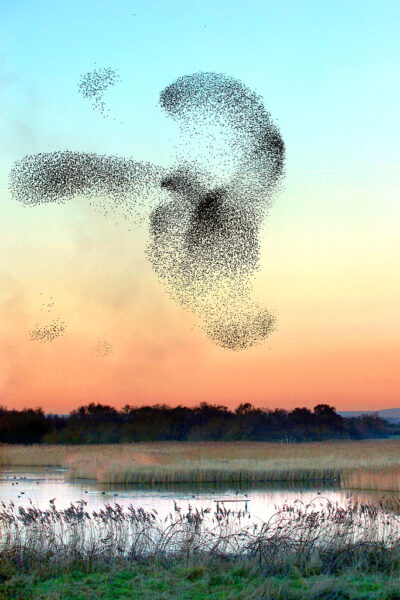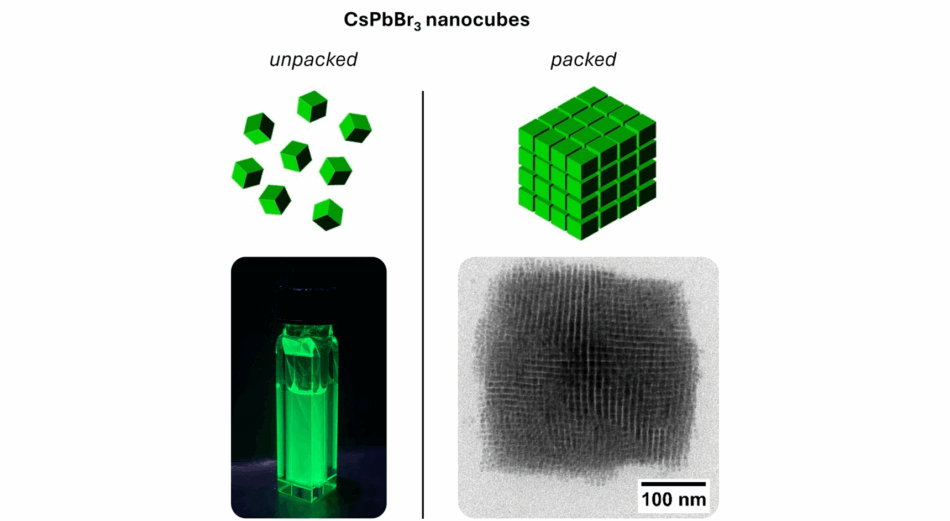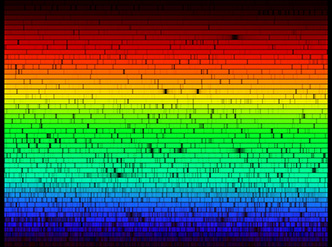Supporting materials
Download
Download this article as a PDF

All together now: discover how the collective behaviour of atoms, humans, and birds inspire researchers to make new light-emitting materials and devices.
What do lasers, clapping audiences, and flocks of birds have in common? They all demonstrate the power of collective behaviour when individual components interact in a way that gives rise to new, often surprising properties. In science, these are known as collective phenomena, and they offer fascinating insights into how synchronization, feedback, and coupling between elements can lead to emergent effects that are greater than the sum of their parts. This concept helps us understand patterns in nature and inspires discoveries in the laboratory.
Light is central to modern life, from the screens we use every day to medical imaging, communication technologies, and solar energy. Scientists aspire to generate light more efficiently, with better control over brightness, colour, and direction, to meet the growing demand for faster, smaller, and more energy-efficient devices. Developing new light sources can also unlock entirely new technologies. In displays and ordinary light bulbs, countless atoms and molecules are excited by electricity to emit light. An excited atom or molecule emits light in random directions, without regard to what its neighbouring emitter is doing. The resulting light emission, called a ’spontaneous emission’, is the familiar glow of a light bulb or a smartphone screen. In comparison, a laser looks and behaves differently. The laser source, such as a laser pointer or a scanner in a supermarket, produces a directional and bright beam of light that is also pure in colour (monochromatic).
What makes a laser different from a light bulb is that atoms inside the laser emit light in a synchronized way, facilitated by the process called ’stimulated emission’. In this process, when an atom is already excited, it can be triggered by a passing photon to release its own photon that looks exactly the same (same colour, direction, and timing). This causes more atoms to do the same, creating a strong, focused beam of light. An interactive simulation of stimulated emission and a laser is a fun way to explore this important phenomenon.[1]

The synchronization of emitters as found in a laser is part of a broader concept known as collective phenomena, and the unusual properties that result from it are called emergent properties. Emergent properties are novel behaviours or patterns that arise from interactions between multiple components, for example, the brightness, directionality, and colour purity of the laser as compared to a light bulb. For such properties to occur, the components must be connected (coupled) and able to respond to changes in each other (feedback). Because emergent properties result from complex interactions, they are difficult to predict from the behaviour of individual parts.

Coupling: Coupling is a connection between objects or processes that enables a change in one object or process to be transmitted to another one. Two locked gears are an example of a system with mechanical coupling. In light emitters, the coupling between them occurs through electromagnetic interactions and fields.
Feedback: Feedback occurs when changes in one object or process influence another one. An example is acoustic feedback: an irritating loud sound heard when a microphone is placed next to a speaker and both are connected through an amplifier. In light emitters, feedback occurs when a photon from one emitter triggers stimulated emission from another.
Emergent property: A property or a phenomenon that is missing in a single object or process, but arises when many objects interact together. In the illustration, a single triangle is a three-sided shape. But when six triangles are arranged together, they form a hexagon, a new shape with six sides that wasn’t present in any individual triangle.
Collective phenomena enable scientists to go beyond the properties of individual atoms or molecules and instead use the coordinated behaviour of many interacting components. This offers new ways to manipulate how materials absorb, emit, or transmit light, enabling the design of materials with properties that are rare or do not exist in nature. To understand these phenomena and how they could be used, we will first look at several examples around us and identify common features. Then we can apply this knowledge to recreate an emergent property in a model experiment and conclude with an example of how it translates into ongoing research in materials science.
To understand how collective behaviour works, we can look at examples from everyday life and nature. These cases reveal how coupling and feedback between individuals, such as people, birds, or insects, give rise to synchronized, collective behaviours without any central control.
People sit in a theatre close enough to hear each other (coupling) and react to vibrations and sound to detect the reactions of others and respond (feedback). Clapping usually starts at roughly the same moment (following the end of the show, for example), but different people start clapping at slightly different times. As the audience synchronizes over tens of seconds, the clapping often speeds up, because hearing a clap just before your own makes you clap slightly faster.[2]
Synchronized clapping is an example of an emergent property. One remarkable feature of an emergent property is that it happens without a leader: synchronization emerges uniformly across the whole group.
Starlings are birds that form large flocks, called murmurations, and exhibit a remarkable synchronized behaviour while flying, seeming to move as if they are a single entity (emergent property).

Murmurations happen because each bird has a wide field of vision and can track about six or seven neighbours simultaneously. Their vision provides coupling, while rapid neuromuscular responses are responsible for feedback by allowing birds to adjust their movement in response to the movement of neighbours.[3]
Some species of fireflies show synchronized flashing patterns; random flashes gradually align until the entire group flashes in unison.

Feedback is visual (seeing neighbours’ light), and coupling arises from being close enough to detect it. The exact function is debated, but one idea is that synchronization helps them find mates more effectively.
Science is inseparable from the world that surrounds us and is rooted in explaining natural phenomena by forming and testing hypotheses and replication by experiment. If we want to check that coupling and feedback play an important role in starling murmurations, it would be rather difficult to catch hundreds of birds and convince them to fly in sync so that we can study them in the classroom. Instead, there is a simpler model that reproduces key elements of collective effects using metronomes.[4] This demonstration recreates the emergent property of collective synchronization, yet does not involve a living system, which suggests that we successfully captured at least the main principles behind cooperative effects.

In the classic metronome synchronization experiment, several metronomes are placed on a light platform resting on empty aluminium cans on a flat surface, so that the platform is balanced and can roll lightly. As each metronome ticks, it imparts a small motion to the platform, which in turn affects the other metronomes, so if the metronomes are started one by one, they will slowly synchronize. If your school has some metronomes, you can try it yourself!
If, instead of metronomes, we had electrons in atoms or molecules, oscillating to produce visible light, then initially, when the oscillations are random and not synchronized, we would see diffuse light like that of a light bulb. But once coupling and feedback are introduced, the oscillations become synchronized and the emitted light changes to become directional, bright, and monochromatic (a single colour). Laser physics and device engineering are complex areas of research but cooperative behaviour is one way to describe these properties.
By combining basic studies of synchronization in physical systems with practical research into light sources, scientists around the world are exploring ways to study collective phenomena for technological use. For example, researchers at Lund University are studying the collective phenomena of light emission in nanomaterials to create energy-efficient light-emitting devices with improved properties, and ‘quantum dots’ are a promising application.
Quantum dots are tiny particles, just a few nanometers in size. They emit light when excited by external energy, such as UV light, in a process known as photoluminescence. Because of the small size of quantum dots, a quantum mechanical effect called ‘quantum confinement’ makes it possible to tune their colours by changing their size. For example, dispersions of CdSe quantum dots with sizes ranging from about 3 to 5 nm emit colours from green to orange under UV light.

The development of colloidal quantum dots was recognized with the 2023 Nobel Prize in Chemistry, awarded to Alexei Ekimov, Louis Brus, and Moungi Bawendi.[5] Though they may sound like science fiction, quantum dots are already used in commercial devices, such as TV displays and computer screens, where they enhance colour purity and brightness for more vivid and energy-efficient visuals. If you notice a screen marketed with the words NANO, QLED, or QNED in the name, you know that some of the colours you see are coming from these tiny particles.
A very popular example of quantum dots is CsPbBr3, which is the topic of my research. In this material, atoms of caesium (Cs), lead (Pb), and bromine (Br) form a crystalline perovskite structure that supports efficient light emission. We are particularly interested in quantum dots of CsPbBr3 that are shaped like cubes (also called nanocubes). Nanocubes show potential for collective light emission because they can pack perfectly together, thus increasing the coupling and feedback needed for new properties to emerge.[6]

If the mechanical metronomes from the example above are replaced with nanocubes, their synchronized photoluminescence is called superradiance or superfluorescence.[8] The terms ’radiance’ and ‘fluorescence’ describe the different ways light is emitted, depending on how energy is released from the excited states of the nanocubes. The prefix ’super’ refers to the enhanced brightness and speed of the emission. These characteristics make superradiance and superfluorescence promising for applications requiring fast and intense bursts of light, such as sensing, optical communication, and quantum information.

However, achieving this collective behaviour under everyday conditions is a major challenge. Coupling and feedback between nanocubes occur through electromagnetic interactions and fields. At room temperature, the atoms inside quantum dots jiggle too much and these motions prevent efficient coupling and feedback, making synchronization more difficult. Thus, temperatures as low as those of liquid helium (−269 °C) are required to see strong emission. Despite the challenges, these nanocubes are promising for real-world applications because of their ease of synthesis and very bright emission.
From audiences clapping to cutting-edge nanomaterials, collective phenomena reveal how simple interactions between many parts can give rise to new, emergent properties. By understanding and utilizing these effects, scientists are opening new ways to design materials and control light.
The work of Dmitry Baranov is supported by the European project Prometheus (https://cordis.europa.eu/project/id/101039683) and the Swedish Research Council (https://portal.research.lu.se/en/projects/nanocrystal-solids-for-quantum-technology).
[1] Teaching resource on the simulation of stimulated emission and lasers: https://phet.colorado.edu/en/simulations/lasers
[2] Thomson M, Murphy K, Lukeman R (2018) Groups clapping in unison undergo size-dependent error-induced frequency increase. Scientific Reports 8: 808. doi: 10.1038/s41598-017-18539-9
[3] Parisi G, Parisi A, Carnell S (2023) In a flight of starlings: the wonders of complex systems. Penguin Press. ISBN: 978-0593493151
[4] Pantaleone J (2002) Synchronization of metronomes. American Journal of Physics 70: 992-1000. doi: 10.1119/1.1501118
[5] The development of colloidal quantum dots was recognized with the Nobel prize in Chemistry 2023: https://www.nobelprize.org/prizes/chemistry/2023/summary/
[6] A glimpse from the author into the research process involved in building superlattices out of nanoparticles: https://www.linkedin.com/pulse/superlattices-frying-pan-dmitry-baranov/
[7] Baranov D et al. (2019) Investigation into the Photoluminescence Red Shift in Cesium Lead Bromide Nanocrystal Superlattices. Journal of Physical Chemistry Letters 10: 655–660. doi: 10.1021/acs.jpclett.9b00178
[8] Raino G et al. (2018) Superfluorescence from lead halide perovskite quantum dot superlattices. Nature 563: 671-675. doi: 10.48550/arXiv.1804.01873
Download this article as a PDF

Take a CD and a cereal box, and what do you have? With a little help from Mark Tiele Westra, your very own spectrometer! Time to explore the delights…

From science fiction to reality: explore how continued innovation in 3D printing is supporting scientific progress in a range of different fields.

Tick tock: Did you know that there are secret clocks ticking inside living organisms, including us? Let’s dive into the science of biological oscillators.